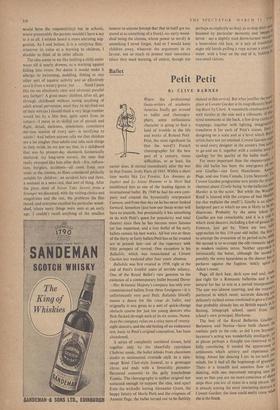Ballet
Petit Petit
By CLIVE BARNES WHEN the professional thesis-writers of academic America finally get around to ballet and choreogra- phers, some enthusiastic character is going to find a load of trouble in the life and works of Roland Petit. Petit, the most significant (is that the word?) French 'choreographer for the best part of a century, raises difficulties, or at least, his career does. It started immediately after the war in that frozen, lively Paris of 1945. Within a short time works like Les Forains, Les Amours de Jupiter and Le feline Homme et la Mort had established him as one of the leading figures in international ballet. By 1949 he had his own com- pany and created the hysterically overpraised Carmen, and from that day on he has never looked forward. Somehow (just how our thesis-writer will have to unearth, but presumably it has something to do with Petit's quest for popularity and total theatre) since then he has become more famous yet less important, and a tiny fistful of his early ballets remain his best works. All but two or three of the thirty or forty ballets Petit has so far created are at present lost—out of the repertory with little prospect of revival. One exception is his Ballabile, which was resuscitated at Covent Garden last weekend after four years' absence.
Ballabile was first created in 1950, right at the- end of Petit's fruitful years of terrible infancy. One of the Royal Ballet's rare gestures to the existence of a contemporary ballet beyond Dover —Her Britannic Majesty's company has only ever commissioned ballets from three foreigners—it is unfortunately very petit Petit. Ballabile literally means a dance for the corps de ballet, and originally it was given as a sort of quick-change obstacle course for just ten young dancers who flick-flacked through each of its six scenes. Nowa- days the company relies on a relay team of twenty- eight dancers, and the old feeling of an endurance test, basic to Petit's original conception, has been abandoned.
A series of completely unrelated scenes, held together only by the cheerfully capricious Chabrier music, the ballet whisks from classroom studio to sentimental riverside idyll, to a rain- swept Rend Clair-style funeral, to a grotesque circus and ends with a feverishly pimento- flavoured ensemble to the gaily knockabout Espana. The choreography is neither original nor sustained enough to support the idea, and apart from the wickedly leering Alexander Grant, the happy fatuity of Merle Park and the crispness of Annette Page, the ballet turned out to be flabbily danced at this revival. But what justifies the work' place place at Covent Garden is its magnificently brood ing decor by Clay& A mammoth constructivist sit with trestles at the side and a silhouette of shun tered tenements at the back, a few drop cloths and trappings, together with lighting, imaginativel transform it for each of Petit's scenes. Here I; designing on a scale and at a level which 1011t , artists have not yet attained. Covent Garden oug''' to send every designer in the country free to go and see it, together with a suitable letter ° apology for the quality of the ballet itself. Far more important than the reappearance e this old ballet has been the emergence of tWe new Giselles—one from Manchester, Annette Page, and one from Canada, Lynn Seymour. The Covent Garden programme now prints the revere, chestnut about Giselle being `to the ballerina when Hamlet is to the actor.' But while the Wilted° Road is littered with the corpses of bad flanilet5, (so that explains the smell!), Giselle is an afro° foolproof part in which no one is likely to be le° disastrous. Probably by the same token fett:,, Giselles are too remarkable, and it is a role I" which most dancers, including a few of genius Fonteyn, just get by. There are two approaches to this 119-year-old ballet; the first:" to attempt the evocation of its period style, while the second is to re-create the old romantic WI in modern realistic terms. Neither approach intrinsically the better, although the second j5 possibly the more hazardous as the dancer has l° perform against the fugitive, tinkly spirit °f Adam's music. Page, all dark hair, dark eyes and soul, looks just right for a Romantic ballerina and it was natural for her to aim at a period interpretation- The aim was almost unerring, and she created de portrayal in which sweet, accurate dancing an delicately stylised mime combined to give a Gise!', that probably already has no British equals in Its, fleeting, lithograph school, apart from the' school's own principal, Markova. The best of the Royal Ballerina Giselles-H Beriosova and Nerina-41ave both chosen the -- realistic path to the role, as did Lynn Seyni°°e; Seymour's acting was wonderfully intelligent. Ye' in places perhaps a thought too contrived to be fully convincing. It needed the appearance of artlessness which artistry and experience el°1 bring. About her dancing I am in no such two minds, for it had all the beginnings of greatness' There is a breadth and seamless flow to her dancing, with one movement merging into the next so that you are no more conscious of dance steps than you are of notes in a sung phrase. She, is already among the most interesting dancers al Covent Garden; the time could easily come whey she is the finest.










































 Previous page
Previous page